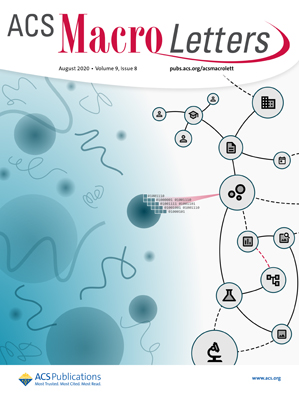基于原子转移自由基聚合和Click化学的水溶性金属聚合物电催化剂的功能化研究
IF 5.1
Q1 POLYMER SCIENCE
引用次数: 0
摘要
二硫化二铁[2Fe-2S]金属聚合物电催化剂的聚合物支撑相的多种功能化为通过水裂解增强分子氢的生成提供了一条途径。点击化学已被证明是一种有用的工具,可以在温和条件下对广泛的聚合物材料进行聚合后功能化,这是[2Fe-2S]金属聚合物的要求,因为活性位点存在铁羰基(Fe-CO)键。在这项研究中,我们开发了一种新的合成方法,利用原子转移自由基聚合(ATRP)和叠氮-炔“点击”环加成的聚合后功能化[2Fe-2S]金属聚合物。采用3-叠氮基甲基丙烯酸丙酯(AzPMA)与甲基丙烯酸甲酯(MMA)或2-(二甲氨基)甲基丙烯酸乙酯(DMAEMA)进行ATRP,然后与官能团末端炔进行铜催化的“点击”环加成,制备叠氮基功能化金属聚合物[2Fe-2S]。在点击化学反应后,PMMA和PDMAEMA功能化[2Fe-2S]金属共聚物家族都在催化剂活性位点保留了Fe-CO键,更重要的是,在ph中性水条件下,PMMA和PDMAEMA功能化[2Fe-2S]金属共聚物家族在电化学水分解中表现出高的电催化活性。本文章由计算机程序翻译,如有差异,请以英文原文为准。

Functionalization of Water-Soluble Metallopolymer Electrocatalysts for Water-Splitting Using Atom Transfer Radical Polymerization and Click Chemistry
The diverse functionalization of the polymeric support phase of diiron disulfide [2Fe-2S] metallopolymer electrocatalysts offers a route to the enhanced generation of molecular hydrogen via water-splitting. Click chemistry has been shown to be a useful tool in post-polymerization functionalization for a wide range of polymeric materials under mild conditions, which is a requirement for [2Fe-2S] metallopolymers due to the presence of iron carbonyl (Fe–CO) bonds in the active site. In this study, we developed a new synthetic methodology to functionalize [2Fe-2S] metallopolymers using atom transfer radical polymerization (ATRP) and post-polymerization functionalization using azide–alkyne “click” cycloaddition. Azide functional [2Fe-2S] metallopolymers were prepared by the ATRP of 3-azidopropyl methacrylate (AzPMA) with either methyl methacrylate (MMA) or 2-(dimethylamino)ethyl methacrylate (DMAEMA), followed by copper-catalyzed “click” cycloaddition with functional terminal alkynes. Both families of PMMA and PDMAEMA functional [2Fe-2S] metallo-copolymers were found to retain Fe–CO bonds from the catalyst active site after the click chemistry reactions and, more importantly, exhibited high electrocatalytic activity for electrochemical water-splitting under pH-neutral aqueous conditions.
求助全文
通过发布文献求助,成功后即可免费获取论文全文。
去求助
来源期刊
CiteScore
10.40
自引率
3.40%
发文量
209
审稿时长
1 months
期刊介绍:
ACS Macro Letters publishes research in all areas of contemporary soft matter science in which macromolecules play a key role, including nanotechnology, self-assembly, supramolecular chemistry, biomaterials, energy generation and storage, and renewable/sustainable materials. Submissions to ACS Macro Letters should justify clearly the rapid disclosure of the key elements of the study. The scope of the journal includes high-impact research of broad interest in all areas of polymer science and engineering, including cross-disciplinary research that interfaces with polymer science.
With the launch of ACS Macro Letters, all Communications that were formerly published in Macromolecules and Biomacromolecules will be published as Letters in ACS Macro Letters.

 求助内容:
求助内容: 应助结果提醒方式:
应助结果提醒方式:


